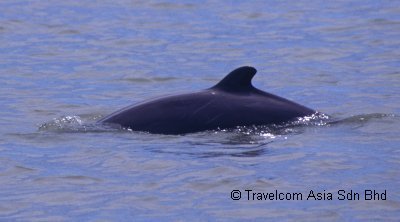Irrawaddy dolphins are not the easiest of dolphins to photograph or film. They are fairly inactive and don’t ‘perform’ for the camera like bottlenose or other oceanic dolphins. So here are a few tips that hopefully will increase your chances of getting a good photo of an Irrawaddy.
1. Make sure you go on a dolphin watching tour with an experienced boatman or tour operator. Currently there are only two operators that are experienced at locating and approaching dolphins - CPH Travel and boat owner Ehrwan from Kampung Buntal.
2. You’ll need at least a 300 mm lens to get a good full frame shot. Saying that if you have a good interaction you may be able to get some good shots with a point and push camera. If you are shooting video, priority number one is to turn off the digital zoom. When you spot a group of Irrawaddys keep the tape running rather than turning the camera on and off. If the dolphins disappear, pick a spot and keep the tape running for while. You might get lucky and capture the dolphins surfacing.
3. Help each other to spot the dolphins. If you see a dolphin tell others on the boat where it is. Rather than saying “over there”, “dolphin”, “this side” or other phrases that don’t indicate the direction, use a clock system as a simple reference tool. 12 O’clock is the front of the boat (the bow for the nautically minded), 6 O’clock is the back (stern) of the boat and so on. If you see a dolphin call out its position (1 O’clock , 10 O’clock, etc) so other people on the boat know where it is.

5. Your chances of taking a good photo are vastly improved if you chance upon a larger group. Yeah I know that’s not exactly rocket science but realistically if you see a small group of 2-4 Irrawaddy dolphins you are better off enjoying the moment rather than getting stressed out trying to take a good photo.
6. If the group you are watching are moving in one direction it is common to miss the first ‘surface’. You hear the ‘blow’, turn round and by the time you click your camera the dolphin is gone. Don’t worry about this and don’t start cursing your bad fortune, you need to keep focused as this may be your chance. Keep the camera directed in roughly the same spot as where the first dolphin surfaced as often a second dolphin or group of dolphins will surface in the same general area, moving in the same direction as the first dolphin.
7. Once you’ve spotted a group try to keep a track of the time between surfaces. Irrawaddy dolphins stay under water for 1-8 minutes, longer if they are scared. So time the surfaces. If the dolphins are surfacing at regular periods (say every 2-3 minutes) then get ready for them.
8. Association with fishing boats. It is quite common to see Irrawaddy dolphins circling small fishing boats. After the fishermen haul in their nets they sort out the fish that they can not sell and throw this ‘trash’ fish back into the sea. This is a good opportunity to get a photo as the situation is more predictable. You can see when the fisherman is about to throw the fish back into the sea and have a good idea where the dolphin will surface.
9. If you are lucky you may observe a dolphin spy hopping (the dolphin pokes its head out of the water and has a good look around). This does not last for long and is usually over in a few seconds, so you have to be quick if you want to get a picture. Occasionally you may see a group gather on the surface and splash around bit, sometimes slapping their fins at each other. This social interaction provides a good opportunity to get a photo as the dolphins are on the surface for longer than usual.
10. So any chances of getting lucky and photographing something special? Well the ultimate would be to capture an Irrawaddy dolphin breaching, jumping clear out of the water. But to photograph this you have to see it and the chances are slim. I’ve only seen an Irrawaddy dolphin jump out of the water on three occasions. Two of these were low horizontal leaps where part of the dolphin was still in the water. But the third was a full breach. I didn’t manage to capture this on film as I was too late and ended up with a photo of a big splash but no dolphin. But a good friend of mine Stuart Green got the shot and captured the early part of the jump. And he knew it at the time; even during the excitement of the moment, he knew he had the shot.
2 comments:
gud article joe... i knew about this fish but never knew that the name was recognised in english... i come from Gedong, and this has been a talk since my childhood time,(my father always talk about this as he raised us from a catch from river..u can spot it along the btg sadong river especially from kpg lubok punggor onward....i still instill the interest in myself but no chance to materialised to date to follow the group of empesut... in 1988, there eas even a whale found dead in kampong lubok punggo if anyone can remember.. most of its bone are still in the resident glass display in thier house
anyway u can find lots of wierd creature in btg sadong.. i.e bauk, remis, lokan, ikan bulu, ikan mutan, nyelor, ikan murak (flying fish-hundreds of them wouldjump into the air if the detected a sound)
gud job once again
Great articles. I learnt a lot from your blog about Sarawak Dolphins. I have a question. Does this kind of dolphin only exsit in Malaysia?
Post a Comment